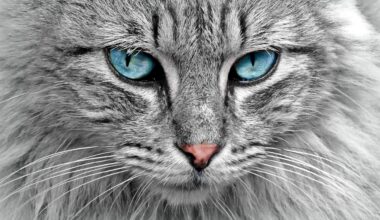Recognizing and Addressing Jealousy in Cats Living Together
Jealousy in cats living in multi-cat households can be a complex challenge. Understanding the root causes of jealousy is essential for managing it effectively. Cats are territorial beings, and when multiple felines coexist in a single space, competition can arise. This competition often stems from resources such as food, space, litter boxes, and even attention from their human caregivers. Jealousy may manifest through several behaviors, which can sometimes be misinterpreted as aggression. Observing these behaviors is crucial in identifying jealousy among cats. Behaviors like blocking access to resources or aggressive posturing can indicate jealous feelings. Additionally, changes in vocalization patterns when one cat receives affection may suggest jealousy as well. Helping your cats feel secure and content can minimize these issues. Ensuring each cat has its own resources and safe spaces can mitigate competition. A well-structured environment promotes harmony and reduces jealousy-related incidents. By understanding these dynamics, caregivers can foster a peaceful multi-cat environment. Care should be taken to recognize signs of jealousy in order to maintain a healthy atmosphere in the household.
Building a nurturing environment for multiple cats requires keen observation of their interactions. Each cat has its unique personality, and understanding individual differences is crucial. Cats possess distinct behavioral traits influenced by their past experiences and early socialization. Some cats may be more confident, while others could be shy, leading to potential jealous feelings when attention is distributed unevenly. Monitor how they respond during feeding time or play sessions to identify jealousy triggers. Establishing routines where each cat gets individual time and attention can help alleviate feelings of competition. Equal distribution of resources is vital; ensure that there are enough feeding stations, water bowls, and litter boxes. The ideal ratio to maintain harmony is to have one more resource than cats. Understanding social hierarchy within the household can also aid in addressing jealousy issues. Sometimes older cats may dominate, making younger ones feel insecure. Interventions may be necessary to equalize their standing. Introducing interactive toys that encourage joint play can help foster cooperation and fun amongst the cats. Lastly, consider engaging in activities that allow each cat to shine, reducing jealousy and promoting a loving atmosphere.
Understanding Cat Jealousy Triggers
Identification of jealousy triggers is key in managing a multi-cat household effectively. The most common indicators of jealousy often arise during feeding times or when one cat receives disproportionate attention from their caregiver. A cat might feel threatened when another gets affection or comes close during playtime. Another significant aspect to consider is the introduction of new pets into the household. New arrivals might provoke feelings of insecurity in established cats, leading to jealousy-driven behaviors. It’s important for caregivers to notice various responses, as these behaviors are pivotal in understanding group dynamics among cats. Scent marking is one clear sign that one cat feels territorial and perhaps jealous of another. Be observant of changes in litter box usage, eating speed, or vocalizations, as these might suggest underlying jealousy issues. Creating a peaceful atmosphere takes effort, but proactive steps can be beneficial. After identifying the triggers, caregivers should make necessary adjustments, like providing secluded areas where the cats can feel safe. By fostering understanding of these triggers and recognizing behavioral changes promptly, owners can more easily address jealousy among their beloved feline companions.
Mitigating jealousy requires proactive measures to avoid escalation of negative behaviors among cats. One effective strategy involves implementing separate feeding zones. This ensures that each cat can eat in peace without competition. Adding enrichment activities can also alleviate boredom that may lead to jealousy. Engaging your cats in play with interactive toys mimics hunting behavior and strengthens bonds while reducing feelings of rivalry. Consistent usage of positive reinforcement can encourage calm interactions. When a cat displays patience and restraint around another, immediate praise can promote similar future behaviors. Redirecting aggression or jealousy with treats or play can further reinforce positive habits. Moreover, offering vertical spaces like cat trees or shelves encourages independence, allowing cats to claim their territory. Recognizing and rewarding cooperative behavior can also foster a sense of community among the cats. Regularly monitored introductions to new cats, with gradual acclimation, will also help significantly. Each time a new cat joins the household, provide separate areas initially before merging spaces. Building trust slowly can alleviate feelings of jealousy while promoting a peaceful coexistence. Ultimately, consistency in routine helps cats feel safe and secure, which minimizes jealousy.
Creating a Peaceful Household for Felines
Addressing jealousy among cats in multi-pet homes can often require creative strategies and intentional planning. The cornerstone of a harmonious environment is to ensure that every cat feels safe and acknowledged. One effective method involves scheduling dedicated playtime or attention for each cat. This dedicated time creates a sense of belonging for individual cats, thereby reducing competition. Early intervention using techniques such as clicker training can promote positive interactions and diminish aggressive or jealous behaviors. Owners may also benefit from creating multiple play areas throughout the home, dedicated to each cat. Diversifying the environment adds intrigue while allowing some cats to retreat when they feel insecure. Another significant aspect is scent exchange among cats as it can build familiarity and reduce jealousy. Using items such as blankets or toys to transfer the scent of one cat to another can help achieve this goal. Encouraging shared experiences, like group play sessions, can create bonds and alleviate tension. Harmony among cats becomes achievable through diligence and a willingness to cater to each of their specific needs effectively pursuant to their dynamic personalities.
Learning to read cat body language significantly aids in understanding jealousy and behavioral responses among cats. Signs of jealousy can often manifest as sudden assertive behaviors, including hissing, swatting, and blocking access to spaces. Understanding these indicators is essential, as they can complicate relationships among household cats. Additionally, adopting a non-aggressive approach to handling these situations fosters trust. Ridgeback cats may take time to adjust to another feline’s presence, and patience is vital during this process. If jealous behavior persists, caregivers may need to seek assistance from a veterinarian or an animal behaviorist. The professional can provide insights tailored to the specific household dynamic. Moreover, health concerns resulting from stress due to jealousy may cause behavioral issues that need addressing. Providing calming aids, like pheromone diffusers, can help mitigate stress and anxiety among cats. It’s critical to continuously assess the household’s atmosphere, making changes conducive to the physical and emotional well-being of all cats. Maintaining clear communication with the cats conveys love and reassurance, ultimately fostering relationships that are grounded in mutual respect.
Conclusion: Promoting Harmonious Relationships
Fostering peaceful relationships among cats in a multi-cat household comes down to a blend of observation, understanding, and dedication to their well-being. As guardians, being aware of jealousy dynamics is vital. Each cat possesses their own temperament, necessitating tailored approaches to interaction and care. Establishing a predictable routine not only lowers the likelihood of jealousy but also instills a sense of stability in their environment. Engaging in regular activities that promote exercise and stimulation plays a pivotal role in minimizing potential conflicts. It is equally important to celebrate moments of camaraderie among the cats, reinforcing positive interactions with praise and rewards. By recognizing signs of jealousy and responding appropriately, caregivers can create a nurturing atmosphere that encourages mutual respect and sociability. Formulating strategies to address issues can make significant improvements to household harmony. Sometimes, even the smallest adjustments can have a profound effect on relationships among cats. In conclusion, by fostering a supportive environment, observing behaviors closely, and making necessary changes, caregivers can ultimately cultivate a loving and peaceful home for all their feline friends.


